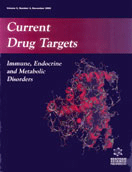Abstract
AIDS has become the greatest pandemic in the human history counting approximately 40 millions people worldwide. To purge HIV-1 infection, new therapeutic approaches need to be searched in alternative and / or in addition to the current pharmacological ones. Recently, several independent laboratories have unveiled a nonimmune intracellular anti-HIV-1 defense strategy based on the cytidine deaminase APOBEC3G, which restricts HIV- 1 production by directly mutating the proviral DNA in infected cells. To counteract this defense pathway, HIV-1 has developed an evasion strategy by acquiring the accessory protein Vif, which blocks the action of APOBEC3G by inducing its proteasome-mediated degradation.
Keywords: vif, f12-vif, apobec3g, apobec3f, hiv-1, anti-viral therapy, non-immune defense
Current Drug Targets - Immune, Endocrine & Metabolic Disorders
Title: Blocking HIV-1 Vif Restores a Natural Mechanism of Intracellular Antiviral Defense
Volume: 4 Issue: 4
Author(s): Chiara Bovolenta
Affiliation:
Keywords: vif, f12-vif, apobec3g, apobec3f, hiv-1, anti-viral therapy, non-immune defense
Abstract: AIDS has become the greatest pandemic in the human history counting approximately 40 millions people worldwide. To purge HIV-1 infection, new therapeutic approaches need to be searched in alternative and / or in addition to the current pharmacological ones. Recently, several independent laboratories have unveiled a nonimmune intracellular anti-HIV-1 defense strategy based on the cytidine deaminase APOBEC3G, which restricts HIV- 1 production by directly mutating the proviral DNA in infected cells. To counteract this defense pathway, HIV-1 has developed an evasion strategy by acquiring the accessory protein Vif, which blocks the action of APOBEC3G by inducing its proteasome-mediated degradation.
Export Options
About this article
Cite this article as:
Bovolenta Chiara, Blocking HIV-1 Vif Restores a Natural Mechanism of Intracellular Antiviral Defense, Current Drug Targets - Immune, Endocrine & Metabolic Disorders 2004; 4 (4) . https://dx.doi.org/10.2174/1568005310404040257
| DOI https://dx.doi.org/10.2174/1568005310404040257 |
Print ISSN 1568-0088 |
| Publisher Name Bentham Science Publisher |
Online ISSN 1875-5917 |
Related Articles
-
Novel Antigen Targets for Immunotherapy of Acute Myeloid Leukemia
Current Drug Targets Hepatic MicroRNA Orchestra: A New Diagnostic, Prognostic and Theranostic Tool for Hepatocarcinogenesis
Mini-Reviews in Medicinal Chemistry Mitigative Effects of a Combination of Multiple Pharmaceutical Drugs on the Survival of Mice Exposed to Lethal Ionizing Radiation
Current Pharmaceutical Biotechnology Two Promising Anti-Cancer Compounds, 2-Hydroxycinnaldehyde and 2- Benzoyloxycinnamaldehyde: Where do we stand?
Combinatorial Chemistry & High Throughput Screening Is There an Increased Risk of Lymphoma and Malignancies Under Anti- TNF Therapy in IBD?
Current Drug Targets Flt3 Receptor Tyrosine Kinase as a Drug Target in Leukemia
Current Pharmaceutical Design The Role of Phospholipase D Enzyme(s) in Modulating Cell Signaling: Implications for Cancer Drug Development
Current Bioactive Compounds Cytoplasmic CXCR4 High-Expression Exhibits Distinct Poor Clinicopathological Characteristics and Predicts Poor Prognosis in Triple-Negative Breast Cancer
Current Molecular Medicine Targeting mTOR Pathways in Human Malignancies
Current Pharmaceutical Design Breath Analysis Using SIFT-MS to Assess Metabolic Status in Patients After Gastro-oesophageal Cancer Surgery- a Pilot Study
Current Analytical Chemistry Molecular Targeting of Protein Kinases to Optimize Selectivity and Resistance Profiles of Kinase Inhibitors
Current Topics in Medicinal Chemistry Targeting JAK/STAT Signaling Pathway in Inflammatory Diseases
Current Signal Transduction Therapy Recent Advances in the Development of Selective Mcl-1 Inhibitors for the Treatment of Cancer (2017-Present)
Recent Patents on Anti-Cancer Drug Discovery The Novel Role for Lyn in Integrin Signaling in Human Disease
Current Signal Transduction Therapy MicroRNAs in Chronic Lymphocytic Leukemia: An Old Disease with New Genetic Insights
MicroRNA In Situ Modulation of Oxidative Stress: A Novel and Efficient Strategy to Kill Cancer Cells
Current Medicinal Chemistry circEPSTI1 Acts as a ceRNA to Regulate the Progression of Osteosarcoma
Current Cancer Drug Targets Potentiation of Anti-Cancer Treatment by Modulators of Energy Metabolism
Current Pharmaceutical Biotechnology Intracellular ROS Generation Mediates Maleimide-induced Cytotoxicity in Leukemia Cells
Anti-Cancer Agents in Medicinal Chemistry Innate Immunity and Intracellular Trafficking: Insights for Novel Anti- HIV-1 Therapeutics
Current Pharmacogenomics



















